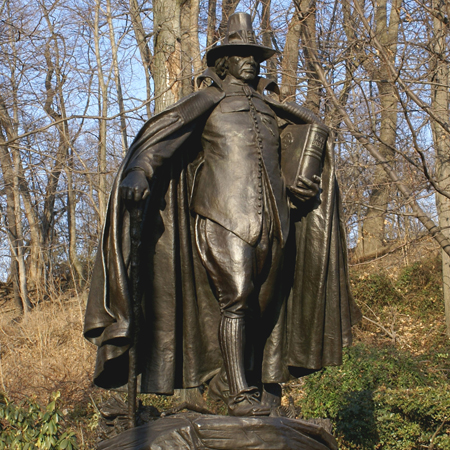The Pilgrim: A Bronze Beacon for Philadelphia
The Pilgrim, a bronze sculpture by Augustus Saint-Gaudens that is part of the City of Philadelphia’s Office of Arts, Culture and the Creative Economy collection, was on the priority list this year in terms of routine maintenance. It had been about twelve years since it has received attention due to limited funding, but is now in the finishing stages of the latest conservation effort directed towards the piece.
 The Pilgrim By Augustus Saint-Gaudens, 1904, based on his earlier sculpture,
The Pilgrim By Augustus Saint-Gaudens, 1904, based on his earlier sculpture, The Puritan in Springfield, Mass.
Photograph courtesy of Wikipedia.
“In certain areas it was clear there was a level of corrosion,” says Margot Berg, Public Art Director, City of Philadelphia’s Office of Arts, referring to the front of the sculpture, top of the hat and the cape.
The sculpture was relocated to its current location on Kelly Drive in 1920.
“Originally, it was located on our City Hall property right in the heart of the city in a very prominent location,” Berg says. “It was representing the importance of the piece in terms of subject matter.”
The sculpture was moved at a time when the area around City Hall was changing.
“The Fairmont park system was being developed as a large city park that also had a significant amount of outdoor sculpture representing American life and the history of our country,” she says.
When looking at The Pilgrim in relationship to their entire collection that includes over 1,000 pieces of public art, it has great significance alone given the stature of the artist who created it.
“It’s a beautiful piece, and the merit of the artist’s work on this particular piece is outstanding,” Berg says.
The New England Society of Pennsylvanians commissioned Augustus Saint-Gaudens to create the piece in 1904.
“He was asked to make a replica of The Puritan that was up in Boston for Philadelphia,” Berg says, referring to the sculpture commissioned by Chester W. Chapin in 1881 that is a large-scale likeness of his ancestor, Deacon Samuel Chappin, one of the three founding fathers of Springfield, Massachusetts.
While similar in some regards, it wasn’t a direct duplicate due to Saint-Gaudens making The Pilgrim specifically for Philadelphia.
“It’s different than The Puritan,” Berg says. “He made changes to what the gentleman is wearing and also to his face and his head.”
With the finishing touches almost complete to enhance the piece’s current state, Berg discusses the process the conservator has been using to remove the corrosion without damaging the bronze.
“He is using walnut shell blasting,” she says. “It’s a fine, ground powder made out of walnut shells and it’s blasted at the sculpture under pressure.”
The next stage of the three to four day process, involves a new coat of wax that is then buffed to bring the bronze to a sheen.
“Every time we treat them, we treat them with a new coat of wax,” Berg says. “We heat the bronze and brush the paste wax on the hot bronze surface and it adheres to the bronze.”
Areas that have a higher amount of corrosion are approached with a different type of wax.
“In the green areas, the conservator went back with a pigmented brown wax to make the sculpture look more what it should look like so you can read the folds in the fabric,” she says.
A significant portion of the city’s collection is made of bronze, which Berg said is a medium that is a signature feature of their collection.
“People still very much want to see them and have them commissioned and representing individuals in populations whose stories have not been told,” Berg says. “The desire for a bronze statue never goes away.”
Resources:
Also in this Issue:
- The Pilgrim: A Bronze Beacon for Philadelphia
- Browne Designs: Forged in Flame and Copper
- Typothecary: Continuing the Art of Copper Letterpressing
- The Bronze Works of Brookgreen Gardens
- Rare Calder Brass Earrings Sold at Lark Mason Auction
